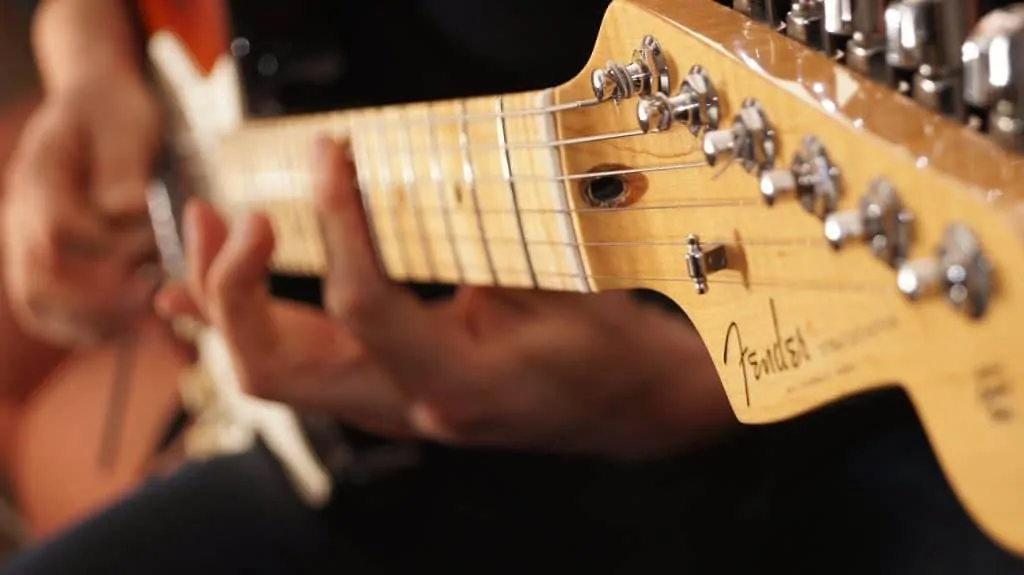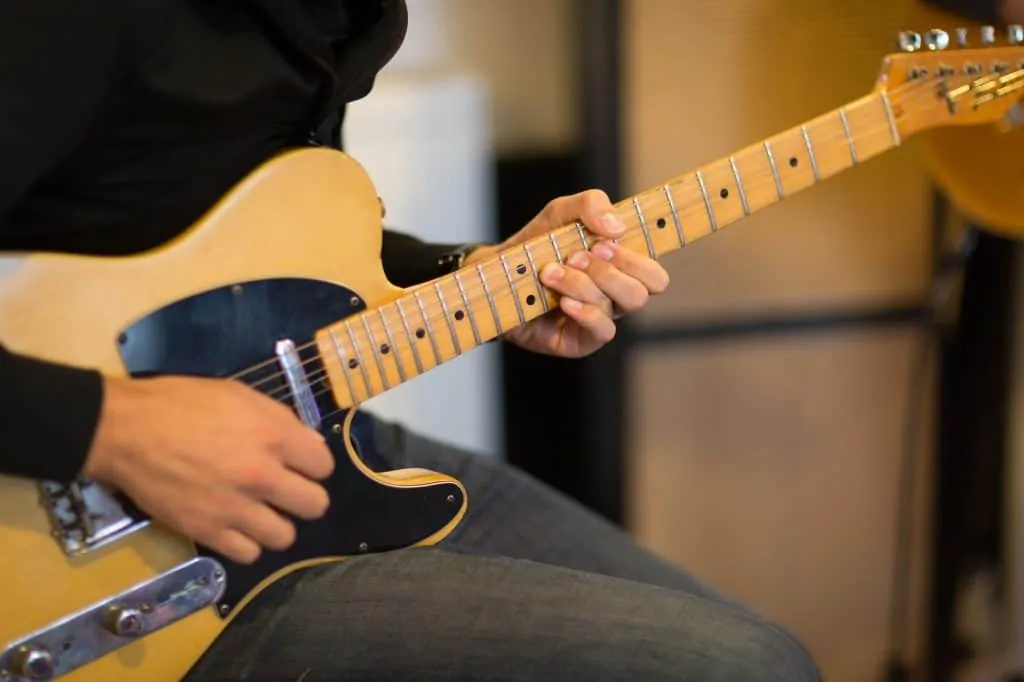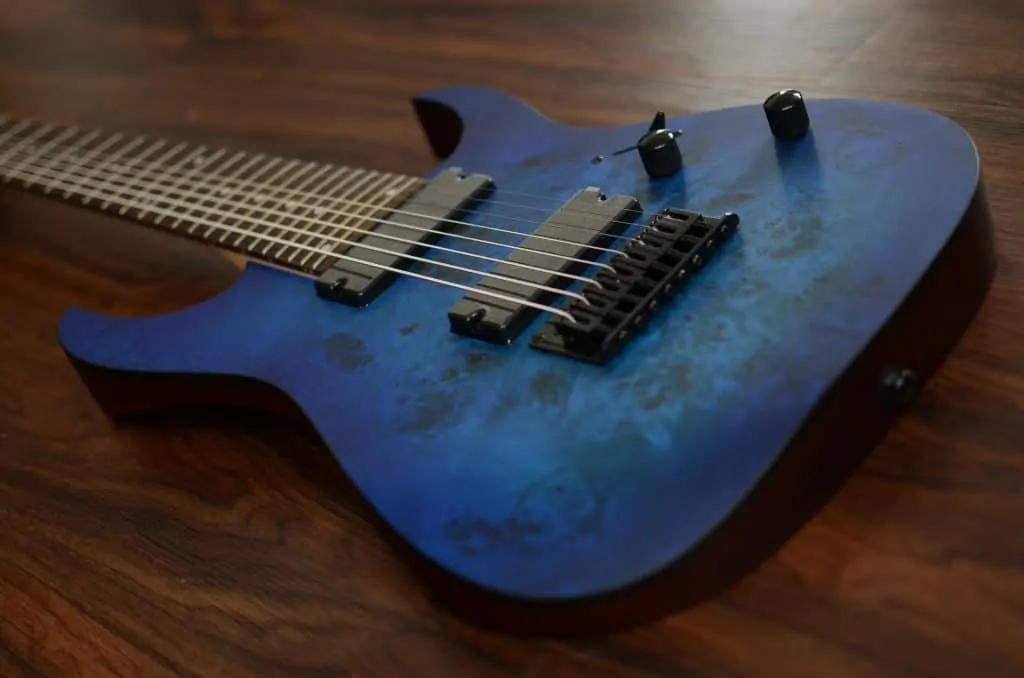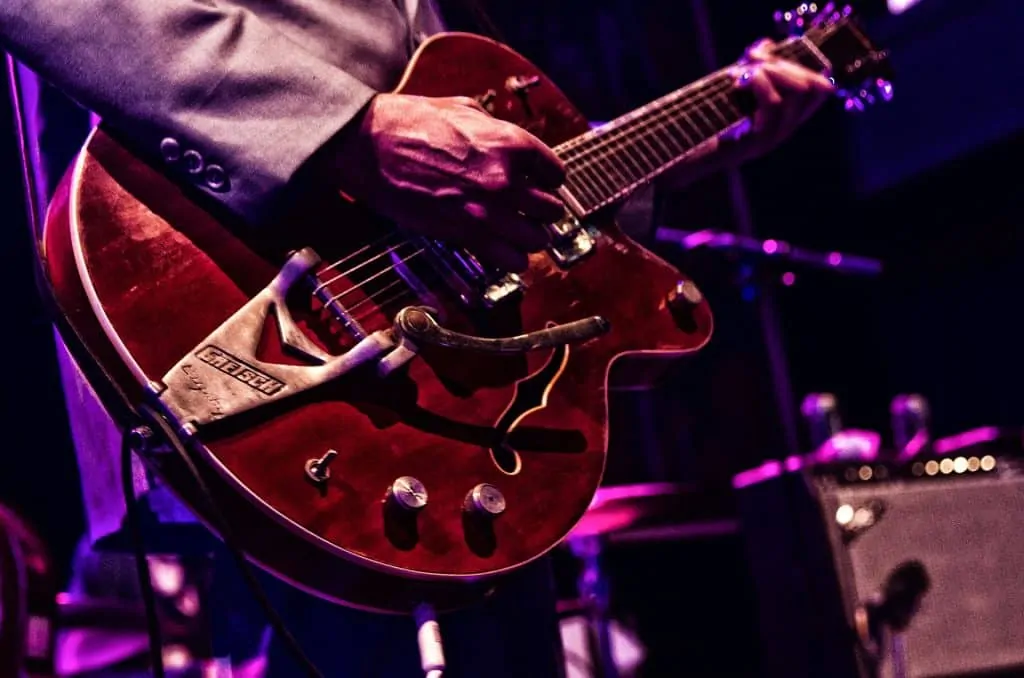Guitar is one of the most popular instruments in the world, used in genres from rock and heavy metal to jazz and highlife. It’s no surprise, then, that various different guitars have evolved to suit different playing styles and genre needs!
Most guitarists begin with a budget, jack-of-all-trades model that can approximate sounds of many different genres. However, players looking to improve their skills in a certain genre may benefit from playing a guitar model suited to their preferred style of music. Here, we take a look at the best electric guitar models for a variety of different genres to help you find one that might suit you best.
Contents
Rock
Rock may be the most popular genre of guitar-based music around. It’s also one of the broadest, which means rock players need a versatile electric axe that can create a variety of different sounds easily.
Great rock guitars must respond well to overdrive. With how prominent driven and distorted sounds are throughout the genre, any rock guitarist needs an instrument that won’t feed back or sound thin when cranked up and driven hard. While there are many classic semi-hollow rock guitars, many of the genre’s biggest legends prefer solid-body models for their more manageable size and reduced feedback.
Different guitars are better suited to play different styles of music. The Fender Stratocaster is one of the most iconic and versatile guitar models in the world.
The top rock guitar is the Fender Stratocaster. With three single-coil pickups and classic double-cutaway styling, this guitar is supremely versatile yet pumps out fantastic tones. The single-coils give it great articulation and clarity, especially on solos and bends. There’s a reason it’s beloved by millions of players worldwide and has become possibly the world’s most iconic guitar. The list of famous Strat users is practically endless, but it includes Eric Clapton, Jimi Hendrix, Ed O’Brien, and David Gilmour, just to name a few.
If you’re looking for something a bit different than a Strat, a Gibson Les Paul is another contender for the title. On the face, it may seem very different from the Stratocaster — the Les Paul offers a pair of humbuckers and just one cutaway, in comparison to the Fender’s three single-coils — but they both deliver fantastic crunch and overdriven sounds, and are versatile enough to play pretty much everything imaginable under the “rock” umbrella. Players like Slash, Jimmy Page, George Harrison, and Jeff Beck have created some of their greatest riffs on Les Pauls.
Finally, some hollow guitars can produce incredible overdriven and crunch sounds. Artists like The Beatles and Gary Clark Jr. are big fans of the Epiphone Casino — a great option if you’re looking for a hollow-bodied guitar or are on a tighter budget. The Casino’s P-90 pickups blend single-coil Stratocaster tone with humbucker-style crunch for a rich and dynamic overdrive that’s been used on some of the greatest rock songs ever made.
Fender Stratocaster Features
- Single-coil pickups
- Double cutaways
- Great clean and overdriven tones
- Versatile enough to play anything rock
Blues
Blues shares a lot of similarities with rock — both are based around the pentatonic scale, and early rock ‘n roll evolved out of electrified blues. However, true blues players often look for a slightly different sound in their guitars.
Unlike rock, which often centers around distortion, up-tempo progressions, and power chords, blues guitar focuses on slower, rhythmic improvisation with delicate phrasing and lighter, crisper overdrive. Blues players need a guitar that can deliver nuanced, harmonic overdrive tones while thickening up their sound and preserving an innate sense of rhythm.
Blues guitarists love semi-hollow guitars like this Gibson ES-335 for their warm, full acoustic tone and thick humbucking pickups.
The Gibson ES-335 is the best guitar for playing blues. The dual humbuckers preserve clean tones, while the semi-hollow body adds a bit of warm acoustic character to your phrasing and overall sound. The vintage styling, complete with F-holes, adds some serious character — playing the blues is nearly as much about style and feel as it is the notes. In this genre, it’s especially important to have a guitar that looks and feels the part. It’s hard to beat the 335’s pedigree, with bluesmen like B.B. King, Freddie King, and John Lee Hooker favoring the model. In fact, B.B. King’s legendary “Lucille” was a custom 335 model.
As mentioned above, there’s a lot of overlap between blues and rock guitar playing — if you’re primarily playing a more uptempo, aggressive blues-rock style, a 335 will work just as well. After all, Eric Clapton made a cherry-red 335 famous when playing Cream’s mixture of hard rock and blues. Alternatively, players like Stevie Ray Vaughan and Buddy Guy favored Stratocaters for their playing. That guitar is another great option.
Gibson ES-335 Features
- Semi-hollow body for warmer, fuller tone
- Gibson PAF humbucker pickups
- Vintage F-hole styling and shape
- Adaptable to play rock and jazz beyond blues
Indie
Like rock, “indie” is a broad genre, encompassing artists from R.E.M. and The Smiths through modern acts like Tame Impala. While lots of indie music may share little in common, many bands employ shimmering, ambient guitar tones with plenty of effects.
Out of all the most famous indie bands, the most common guitar has to be the Rickenbacker 360. Rickenbackers, and the 360 model in particular, excel at indie’s bright, crisp sounds and are well-suited to layering different tracks with various effects and tones. On top of their sound, Rickenbackers are also known for their thinner necks, well-adapted for playing arpeggios and broken or partial chords. Their distinctive playing character and jangly tones make Rickenbackers the best guitar for indie music.
The Rickenbacker 360, a favorite of indie and alternative guitar players for decades. Notice Rickenbacker’s famous Fireglo finish!
Rickenbackers have been employed by indie legends like Johnny Marr, Kevin Parker, and Peter Buck to great effect. Unlike many other electric models, the Rickenbacker also offers a famous 12-string version of the 360 — outstanding for tracking crisp melodies and lending a distinctive shimmer to your signal. It does tend to make changing strings a pain, however!
If you’re looking for a slightly more versatile or budget-friendly model, it’s hard to go wrong with a Fender. The Fender Jaguar offers similar brightness and clarity to a Rickenbacker, but has greater tonal control and better overdrive response for rock and grunge. It’s another indie staple, with Kurt Cobain, Johnny Marr, and Andrew Savage (Parquet Courts) employing the offset classic.
Rickenbacker 360 Features
- Bright, crisp single-coil pickups
- Distinctive thin necks for smooth chordal playing
- Respond great to effects and layer together well
- 12-string version available for extra shimmer
Country
As one of the first genres to adopt the electric guitar, country and rockabilly have a particularly long and distinguished history with the instrument. In particular, the genre is dominated by one model like few others: the Fender Telecaster.
Country guitarists require clear, sparkling tones with plenty of spank and bite. Few guitars can provide these characteristics like the Telecaster, which was one of the first solid-bo dy electric guitars produced for the mass market. The Tele’s single-coil pickups (particularly the famous bridge pickup) can handle plenty of compression without losing tonal clarity — the Tele’s volume and tone knobs are known for being among the most responsive of any electric guitar. And for gigging players, Teles are famous for their durability and no-fuss construction; they can run for years without lots of intensive care or upkeep.
The Fender Telecaster, a versatile and popular electric guitar, especially for country artists looking for twangy clean tones.
Within the country and folk fields, players like Merle Haggard, James Burton, Bob Dylan, and Brad Paisley favor Teles. The guitar is so versatile that many players from other genres are also known for using them, like Muddy Waters, Billy Gibbons, Jonny Greenwood, and Johnny Marr.
If you prefer hollow or semi-hollow models or simply find the Telecaster too straightforward, Gretsch guitars are another great option for twangy country and rockabilly tones. Boasting players like George Harrison, Eddie Cochran, and Chet Atkins, Gretsch models like the G6120 and Country Gentleman deliver bright and chimey tones that are similar to the Telecaster but with the best distinctive hollow-body flair.
Fender Telecaster Features
- Incredible versatility across genres
- Classic single-coil pickups, with famous bridge pickup tone
- Simple and responsive tone circuit
- Extremely durable construction
Metal
While many genres make use of overdrive, metal takes the fuzz to another level entirely. As a result, metal players need guitars that can stand up to incredible levels of distortion and still pump out loud, heavy tones with ease. If you’re playing metal, you’ll also want a fast and flatter neck for shredding solos across the fretboard and for tapping, a technique which is nearly exclusively used in metal.
Because of the demanding output requirements, many metal guitars feature active pickups to add in low-end frequencies to your signal and beef up your tone. If you’re looking for a new metal guitar, be sure to pay attention to active and passive pickup options. Similarly, some metal players prefer extended-range guitars with seven or even eight strings.
The Ibanez RG series is possibly the most famous metal guitar ever produced. This 8-string model is especially well-designed for metal subgenres like djent.
With famous players like Dave Navarro, John Petrucci, and Steve Vai, the Ibanez RG series is one of the best guitars available for metal. Its 24-fret neck and 15.75-in fretboard radius are optimized for fast and furious shredding, and its Floyd Rose-style vibrato unit can handle the extreme divebombs metal is famous for. It also offers one of the best pedigrees around — Ibanez were one of the first companies to produce superstrat-style metal guitars, way back in the 1970s.
Ibanez RG Features
- Flatter, longer neck for expressive metal solos
- High-output passive pickups designed for high distortion levels
- Durable vibrato unit can handle extreme divebombs
Funk
Funk is all about playing in the pocket and finding the groove as a guitar player. The treble-heavy chords and rhythmic palm muting make this genre one of the hardest to master as a guitarist. The perfect funk tone is similarly tricky.
Most funk guitarists go for a clean sound with lots of top-end shine and a high electric presence to emphasize their percussive style of play and cut through a crowded mix. Single-coil guitars, especially Fender Stratocasters and Telecasters, are the best guitars to provide the quintessential funk sound.
The Fender Telecaster is one of the oldest and most copied electric guitar designs ever. Its adaptability and clear tones have made it a favorite in country and funk.
Single-coil pickups generally offer more treble and a more defined tonal character than humbuckers. Fender guitars in particular are known for responsive tone control knobs, allowing you to really dial in a crisp, cutting funk tone. Funk giants like Nile Rodgers and Tony Maiden are some famous proponents of Strats and Teles, respectively.
Fender Stratocaster/Telecaster Features
- Bright, airy single-coil pickups
- Responsive tone knob for crisp presence
- Cut through mix better than humbucking guitars
- Versatile enough to play funk fusion and other styles
Jazz
Unlike most other electric guitar genres, jazz players are purists for warm, bassy clean tones. While that rules out many guitars designed for overdrive and distortion, it also opens up a world of hollow-body guitars (sometimes affectionately referred to as “jazz boxes”) that players in many other genres simply don’t consider.
Archtop guitars, particularly Gibson ones, have been the gold standard in the jazz world for decades. The Gibson L-5 is the best guitar for pure jazz players. Its fully hollow body may feel more like an acoustic guitar to unfamiliar players — you can play an L-5 unplugged just like any other acoustic guitar — but the thicker, flatter neck and bass-focused humbuckers are tailored to jazz guitarists.
Jazz guitarists tend to favor hollow-bodied models like this Gretsch for their acoustic capabilities and warm, woody tone. In fact, the first electric guitars were acoustic guitars with pickups added on for big-band jazz guitarists.
It’s not an overstatement to say that archtops are the defining feature of the jazz guitar world. Marrying acoustic projection and depth with electric tone and amplification, they offer a smokier, darker tone than many solid and semi-hollow body models. Jazz guitarists like Wes Montgomery and Kenny Burrell, in particular, have favored L-5s.
However, few guitarists play only jazz — and spending a mint on a jazz-exclusive guitar is out of reach for most players. A Gibson ES-335 is a great option if you need a guitar for jazz that can also adapt to more popular styles. The semi-hollow construction captures much of the L-5’s acoustic airiness, though the 335’s humbuckers are geared much more towards rock and blues styles instead of solely jazz.
It’s also important to keep in mind that jazz as a genre is less focused on brand names than some other styles of guitar music. If your electric axe can produce a warm and buttery jazz tone, that’s all that matters. Rising jazz star Julian Lage, for example, even favors a Fender Telecaster for his burning solos!
Gibson L-5 Features
- Hollow body for acoustic warmth and depth
- Jazz-voiced humbuckers excel at clean and rich tones
- Thicker and flatter neck makes fretting tough chords with all fingers easier
Conclusion
While electric guitars may be ubiquitous, depending on what music you play your “ideal” guitar may vary wildly. No matter what guitar you’re looking for, there are a few tips you can keep in mind to simplify the buying process for your next axe.
Be sure to keep factors like pickup type and number, body style and shape, and neck shape in mind when comparing different models. Knowing what these components do and how they affect your tone is an essential part of being a guitar player.
Don’t be afraid to try out as many different electric guitars as you need to make a decision. And ultimately, don’t be afraid to break the rules! While there are certainly some consensus “best” guitars for different styles of music, each player is unique. Feel and tone are more important than anything else, and your top priorities in any guitar search should be to find a model that both feels and sounds great without boxing yourself in.







